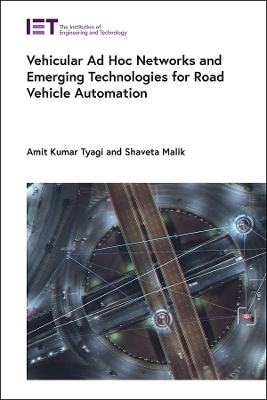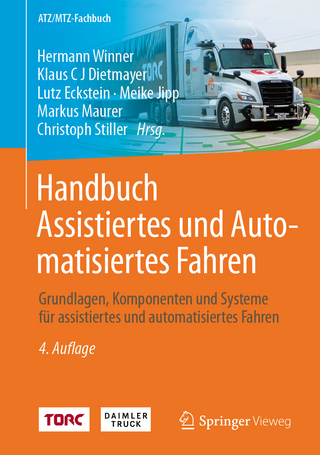
Vehicular Ad Hoc Networks and Emerging Technologies for Road Vehicle Automation
Institution of Engineering and Technology (Verlag)
978-1-83953-428-7 (ISBN)
The automation of road vehicles is still developing, moving towards improved technology, safety, energy and fuel efficiency, comfort, economic growth, and real-world applications. Vehicle connectivity and information exchange over the road is an essential requirement for the future of automated driving. This book is intended to help bridge the gap between theory and applications of autonomous vehicles.
Vehicular Ad Hoc Networks and Emerging Technologies for Road Vehicle Automation covers autonomous road vehicles and systems, with a particular focus on vehicular ad-hoc networks (VANETs). VANETs are a key part of the intelligent transport systems framework. They are created by applying the principles of mobile ad-hoc networks to vehicles; that is, the spontaneous creation of a wireless network of mobile devices based on inter-vehicle communication. Coverage also includes further aspects of autonomous road vehicles, including hybrid vehicles, autonomous intelligent vehicles, and autonomous decentralized systems (ADS).
The book is essential reading for researchers and advanced students from academia, industry and government working on the automation of road vehicles. Additionally, it is a helpful resource for students, researchers and newcomers to the field; providing an in-depth understanding of autonomous road vehicles, their internal structure, types, and fundamental principles, helping to inform and direct their research, and identify challenging areas and problems where further investigations are needed.
Amit Kumar Tyagi is a senior assistant professor (grade-I) and senior researcher at the School of Computer Science and Engineering, Vellore Institute of Technology, Chennai, Tamilandu India. His current research focuses on machine learning with big data, blockchain technology, data science, cyber physical systems, smart and secure computing and privacy. He has contributed to several projects such as “AARIN” and “P3-Block”, addressing some of the open issues related to privacy breaches in vehicular applications. Shaveta Malik is an associate professor in the Computer Engineering Department at Terna Engineering College, University of Mumbai, India, where she has more than 12 years of work experience. She received her PhD from Lingaya's University, Faridabad, India. Her research areas focus on image processing, machine learning, deep learning, and artificial intelligence. She has published number of patents related to machine learning.
Chapter 1: Vehicular Ad Hoc Networks: past, present and future
Chapter 2: MAC layer, Hybrid MAC protocols in Vehicular Ad Hoc Networks (VANETs)
Chapter 3: Opportunistic routing protocols for Vehicular Ad Hoc Network (VANETs) and intelligent transportation system (ITS)
Chapter 4: Forwarding and remote networking in Vehicular Ad Hoc Networks
Chapter 5: Unmanned Aerial Vehicles (UAV) relay in Vehicular Ad Hoc Network (VANETs) against smart jamming with reinforcement learning/deep learning
Chapter 6: Vehicular cloud computing: introduction to cloud-based vehicles
Chapter 7: Advanced vehicle motion control and LTE/5G/6G for vehicular communications
Chapter 8: Computer vision in Autonomous Intelligent Vehicles (AIV)
Chapter 9: Biometric and blockchain-based vehicular technology
Chapter 10: Internet of Things-based vehicular technology (IoV): introduction and its scope
Chapter 11: Intelligent transportation system: Introduction and its scope in the near future
Chapter 12: Autonomous Vehicles (AVs): localization, navigation and tracking/tracing
Chapter 13: Realistic vehicular mobility/channel models for vehicular communications for autonomous intelligent vehicles (AIVs)
Chapter 14: Intelligent network access system for environment perception and modeling in Intelligent Transportation Systems
Chapter 15: Multi-channel operations, coexistence, and spectrum sharing for vehicular communications
Chapter 16: Simulation tools and techniques for vehicular communications and its applications
Chapter 17: Security, privacy, and trust for Autonomous Intelligent Vehicles/Intelligent Transportation Systems
Chapter 18: Future research trends, applications, and standards in emerging vehicle technology
Chapter 19: Conclusion
| Erscheinungsdatum | 03.01.2023 |
|---|---|
| Reihe/Serie | Transportation |
| Verlagsort | Stevenage |
| Sprache | englisch |
| Maße | 156 x 234 mm |
| Themenwelt | Technik ► Fahrzeugbau / Schiffbau |
| ISBN-10 | 1-83953-428-1 / 1839534281 |
| ISBN-13 | 978-1-83953-428-7 / 9781839534287 |
| Zustand | Neuware |
| Haben Sie eine Frage zum Produkt? |
aus dem Bereich


